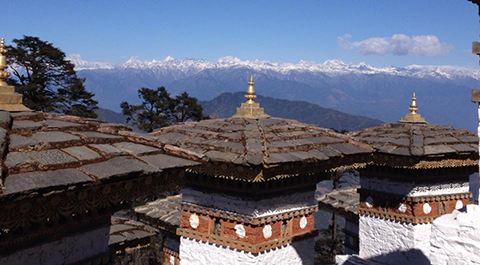 Bhutan and Teton Science Schools:Teton Science Schools (TSS) has a long standing and growing partnership with the Ministry of Education (MOE) and Royal University of Bhutan (RUB). TSS has been working closely with the MOE and RUB to train teachers and lecturers in place-based education, and supporting RUB in creating a Master’s in Education program. Since 2007, Teton Science Schools (TSS) has sent a total of 45 Bhutanese delegates to Jackson Hole and TSS staff to Bhutan. This equals about 665,000 miles of travel over the past eight years! TSS has trained almost 100 educators within the country of Bhutan. On the 10th of January, 2015, TSS staff will conduct a 10-day professional development training in place-based education for 24 teachers from each district or Dzongkhag. In addition, lecturers from RUB will participate. The focus of this workshop will be on the theory and strategies, practice and application, and training and implementation of place-based education. At the completion of the workshop, teachers and lecturers, along with past 2014 Bhutan PBE workshop participants, will become trainers and leaders in place-based education for the Ministry of Education and Royal University of Bhutan. The workshop is facilitated by TSS and the Department of Curriculum Research and Development under the MOE. The workshop will take place in Bajothang Higher Secondary School in Bajothang, Wangdi, Bhutan.We look forward to launching this workshop, and sharing the celebrations of our learning and growth along the way! Bhutan Facts:Bhutan is a landlocked country between India and China. It is around 14,825 square miles, roughly the size of Maryland, and has a population of about 750,000 people. The diverse landscape covers tropical plains and subtropical broadleaf forests around 330 feet in the south to snow covered mountain ranges that border the north. The highest peak in Bhutan is Gangkhar Puensum at 24,840 feet. Fifty-one percent of the total land is protected. The national animal is the Takin (Budorcas taxicolor), which as the myth states, looks like a cow’s body with the head of a goat. Before the 1950s, Bhutan was largely a self-contained traditional rural society that was cut off from the rest of the world. The Fourth Druk Gyalpo, Jigme Singye Wangchuk, was instrumental in establishing modern development, such as road and communication networks, free education, safe drinking water, etc. Bhutan became a democracy and adopted its’ first written constitution in 2008. The Fifth Druk Gyalpo, Jigme Khesar Namgyel Wanghuck, has supported several initiatives for youth, including higher standards in education, and reformed the kidu or welfare system. Gross National Happiness (GNH) was established by the Fourth King as an approach to development, of which the goal is happiness. The four pillars of GNH consist of fair socio-economic development, conservation and promotion of a vibrant culture, environmental protection, and good governance. In the international ranking of happiness, Bhutan ranks 13th out of 178 countries. Bhutan is predominantly a Buddhist country.
Bhutan and Teton Science Schools:Teton Science Schools (TSS) has a long standing and growing partnership with the Ministry of Education (MOE) and Royal University of Bhutan (RUB). TSS has been working closely with the MOE and RUB to train teachers and lecturers in place-based education, and supporting RUB in creating a Master’s in Education program. Since 2007, Teton Science Schools (TSS) has sent a total of 45 Bhutanese delegates to Jackson Hole and TSS staff to Bhutan. This equals about 665,000 miles of travel over the past eight years! TSS has trained almost 100 educators within the country of Bhutan. On the 10th of January, 2015, TSS staff will conduct a 10-day professional development training in place-based education for 24 teachers from each district or Dzongkhag. In addition, lecturers from RUB will participate. The focus of this workshop will be on the theory and strategies, practice and application, and training and implementation of place-based education. At the completion of the workshop, teachers and lecturers, along with past 2014 Bhutan PBE workshop participants, will become trainers and leaders in place-based education for the Ministry of Education and Royal University of Bhutan. The workshop is facilitated by TSS and the Department of Curriculum Research and Development under the MOE. The workshop will take place in Bajothang Higher Secondary School in Bajothang, Wangdi, Bhutan.We look forward to launching this workshop, and sharing the celebrations of our learning and growth along the way! Bhutan Facts:Bhutan is a landlocked country between India and China. It is around 14,825 square miles, roughly the size of Maryland, and has a population of about 750,000 people. The diverse landscape covers tropical plains and subtropical broadleaf forests around 330 feet in the south to snow covered mountain ranges that border the north. The highest peak in Bhutan is Gangkhar Puensum at 24,840 feet. Fifty-one percent of the total land is protected. The national animal is the Takin (Budorcas taxicolor), which as the myth states, looks like a cow’s body with the head of a goat. Before the 1950s, Bhutan was largely a self-contained traditional rural society that was cut off from the rest of the world. The Fourth Druk Gyalpo, Jigme Singye Wangchuk, was instrumental in establishing modern development, such as road and communication networks, free education, safe drinking water, etc. Bhutan became a democracy and adopted its’ first written constitution in 2008. The Fifth Druk Gyalpo, Jigme Khesar Namgyel Wanghuck, has supported several initiatives for youth, including higher standards in education, and reformed the kidu or welfare system. Gross National Happiness (GNH) was established by the Fourth King as an approach to development, of which the goal is happiness. The four pillars of GNH consist of fair socio-economic development, conservation and promotion of a vibrant culture, environmental protection, and good governance. In the international ranking of happiness, Bhutan ranks 13th out of 178 countries. Bhutan is predominantly a Buddhist country.


